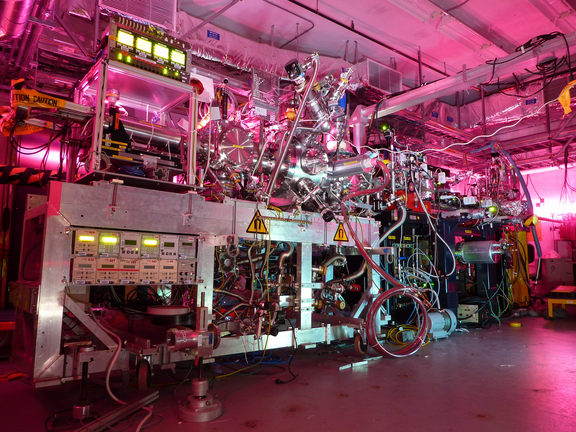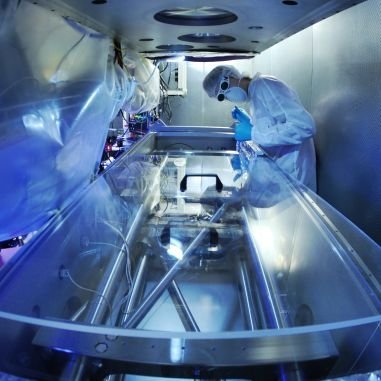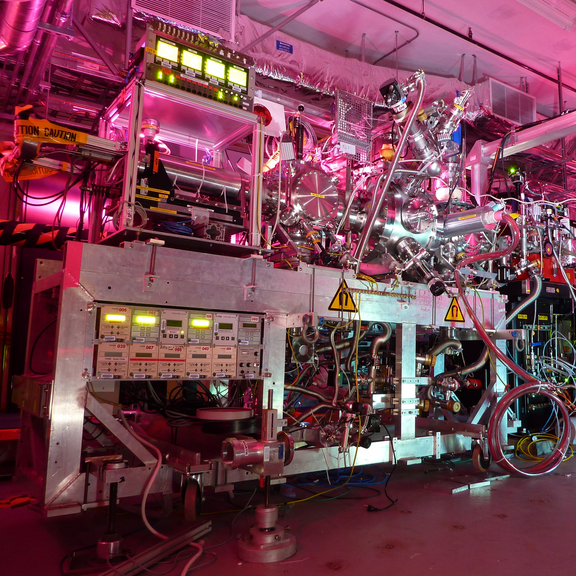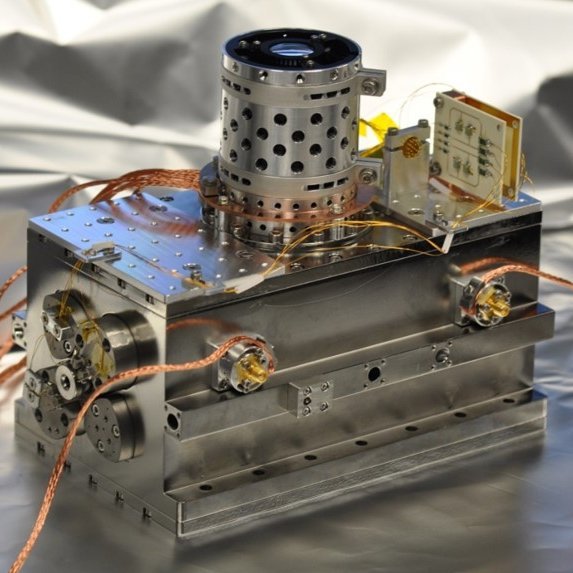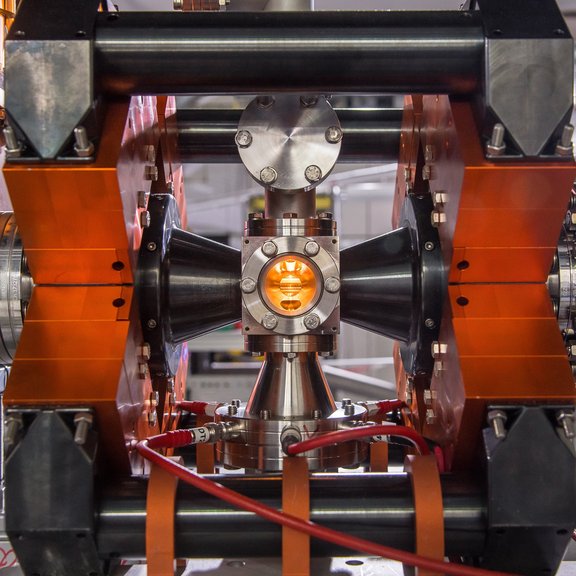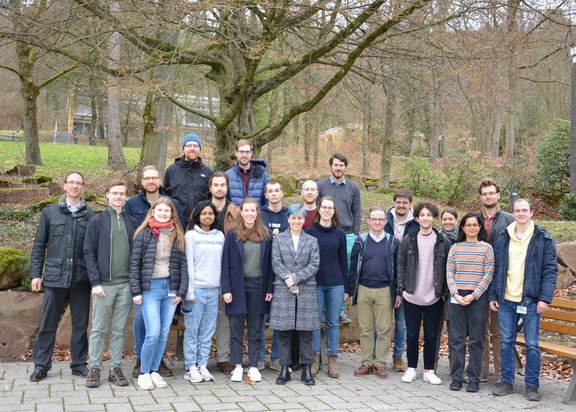Highly charged ion dynamics
Pfeifer Divison
Research Group (AG)
Apl. Prof. Dr. José Crespo
In the interior of stars, around galactic cores and black holes, temperatures of millions of Kelvins are prevailing. Galaxy clusters are enclosed in an extremely dilute, but similarly hot plasma medium; both galaxies and plasma are held together by the gravitational action of the present Dark Matter. In these environments, atoms are in very high positive ionization states, but can absorb and emit radiation with their remaining bound electrons. The spectral lines of such “highly charged ions” are very import in astrophysics, because they come from the hot Universe. In our laboratory, we produce such ions, store them for long time spans, and investigate their spectra from the x-ray to the visible range. Furthermore, we can excite them with lasers and x-ray lasers, or can cool them down to temperatures close to absolute zero. We are developing experiments and techniques to scrutinize the laws of physics to their limits over a temperature range of 12 orders of magnitude:
Where can atomic structure theory be improved? Do we understand astrophysical data correctly? Is it possible to design atomic clocks based on highly energetic photons, where atoms fail but highly charged ions do not? Are fundamental constants of nature perfectly constant?
Heidelberg Compact Electron Beam Ion traps
In an electron beam ion trap highly charged ions (EBIT) can be produced and stored by compressing a mono-energetic electron beam to very high densities. The compression is carried out by strong magnetic fields usually produced by super conducting magnets reaching flux densities from 3 up to 8 T. To reduce size as well as costs and to ease final operation, we developed a room-temperature EBIT employing permanent magnets and reached magnetic field strength of 0.86 T.
The HC-EBITs can be used for spectroscopy of HCIs from the optical up to the x-ray regime. One application for example is the investigation of electron recombination processes with an accuracy never reached before using an EBIT. Furthermore, the produced HCIs can be extracted for experiments like Paul or Penning traps.
Forbidden optical transitions in highly charged ions (HCI) are excellent candidates for new frequency standards because they are only susceptible to external influences to a very small extent. Some of these transitions can be used as a direct test of a variation in fundamental constants of nature because they have a very large sensitivity to the relative change from the fine structure constant and the electron-to-proton mass ratio. Furthermore, quantum electrodynamic effects and also the influences of the atomic nucleus can be measured with extreme precision using the hyperfine structure transitions in heavy hydrogen-like ions.
For such high-precision experiments, HCI must first be trapped and cooled down. At the Cryogenic Superconducting Resonator Paul Trap (CryPTEx-SC), a variety of different species of HCI can be trapped and sympathetically cooled by implanting them into a laser-cooled beryllium ion crystal. In this process, the temperature is reduced by about eleven orders of magnitude from the megakelvin to the low millikelvin range from the ions originally produced in an electron beam ion trap. In addition, the Paul trap is in a cryogenic environment at a 4 Kelvin level, greatly extending the storage times due to the low pressure (<6x10-14 mbar). The novel superconducting resonator, which also acts as a trap, shields the ions from external electromagnetic noise waves. Thus, coherence times in the range of several seconds can be achieved without repeatedly manipulating the ions with special pulse sequences.
To study highly charged ions in the extreme ultraviolet (XUV) with high precision, a coherent ultra-narrow light source in this spectral region is required.
For these reasons, we are developing an XUV frequency comb. High-harmonic generation (HHG) is used to transfer the coherence and stability of a near infrared frequency comb to the XUV. It is very challenging to reach the necessary high intensity levels for HHG, while operating at high repetition rates. Therefore, the comb laser pulses are first amplified in a chirped-pulse fiber amplification setup and then resonantly overlapped in a femtosecond enhancement cavity. To achieve high stability and low-noise performance, the cavity is placed on a rigid titanium structure with vibrational decoupling from the vacuum pumps. High-harmonics are generated in a target gas in the tight focus of the cavity.
The generated XUV light will be coupled out of the cavity and guided towards trapped HCI. By driving narrow transitions with individual comb lines, high-precision XUV spectroscopy of HCI will become possible for the first time
→ Highly charged ion dynamics
Group Crespo| Postdocs | ||
| Dr. Sonja Bernitt (guest) | BO334b | -432 |
| Dr. Elwin Dijck | BO334b | -432 |
| Dr. Tobias Heldt | BO337 | -331 |
| Dr. Jan-Hendrik Oelmann | BO337 | -331 |
| Dr. Chintan Shah (guest) | BO337 | -331 |
| Dr. Moto Togawa (guest) | BO334b | -432 |
| Dr. Christian Warnecke (guest) | BO338 | -278 |
| Dr. Yang Yang (guest) | BO336b | -276 |
| PhD Students | ||
| Marc Botz | BO334b | -432 |
| Lennart Guth | EH3L28 | -569 |
| Ruben Henninger | EH3L28 | -569 |
| Lakshmi Kozhiparambil (guest) | BO336b | -446 |
| Students | ||
| Anant Agarwal | BO318 | -490 |
| Jonas Danisch | BO318 | -490 |
| Sebastian Davidson | EH3K21 | -619 |
| Joschka Goes | EH3K21 | -471 |
| Thomas Heidenreich | EH3K21 | -471 |
| Lukas Matt | EH3K21 | -619 |
| Devanarayanan Rajeeb Kumar | BO318 | -490 |
| Inna Zhang | BO318 | -490 |
